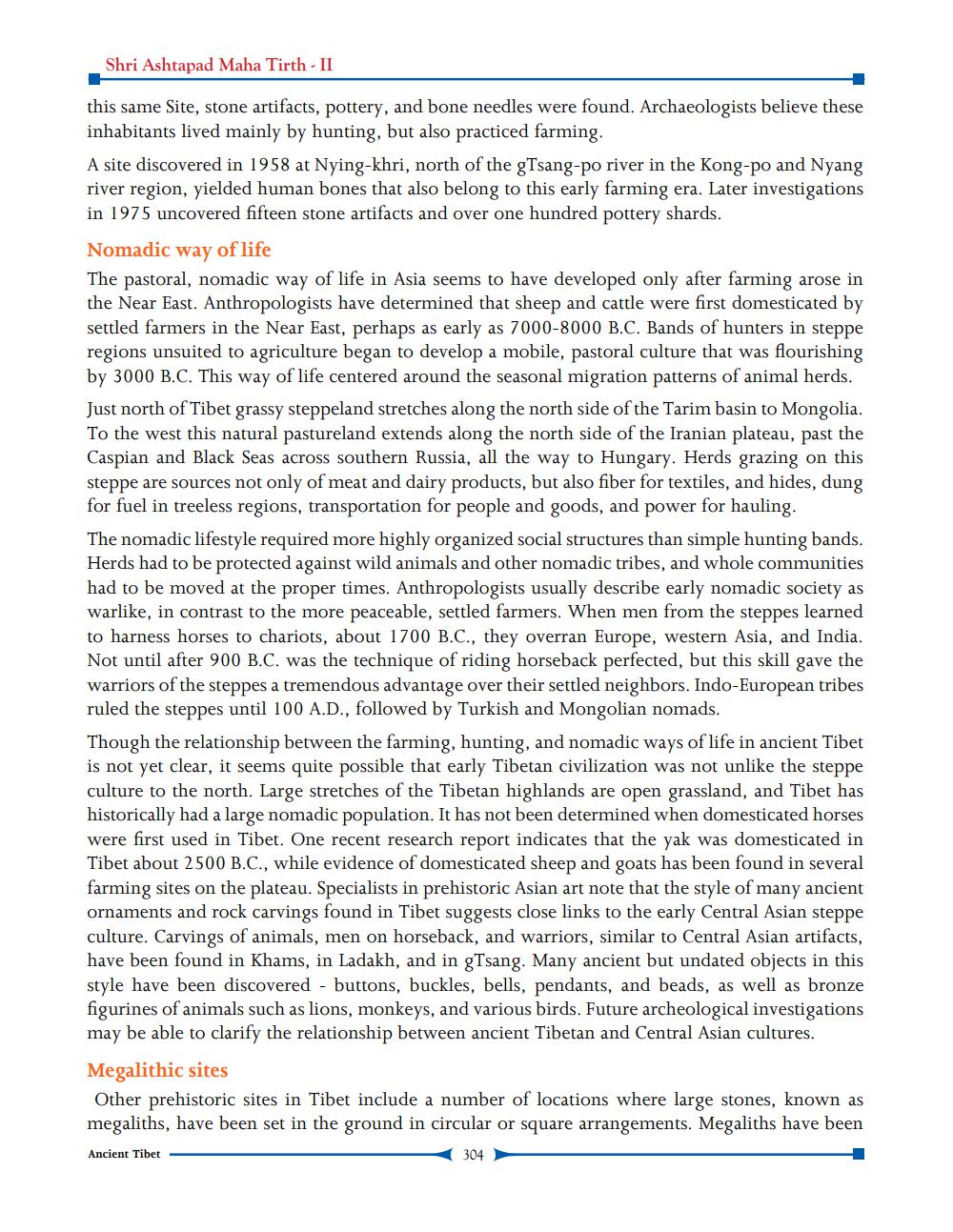________________
Shri Ashtapad Maha Tirth - II
this same Site, stone artifacts, pottery, and bone needles were found. Archaeologists believe these inhabitants lived mainly by hunting, but also practiced farming. A site discovered in 1958 at Nying-khri, north of the gTsang-po river in the Kong-po and Nyang river region, yielded human bones that also belong to this early farming era. Later investigations in 1975 uncovered fifteen stone artifacts and over one hundred pottery shards. Nomadic way of life The pastoral, nomadic way of life in Asia seems to have developed only after farming arose in the Near East. Anthropologists have determined that sheep and cattle were first domesticated by settled farmers in the Near East, perhaps as early as 7000-8000 B.C. Bands of hunters in steppe regions unsuited to agriculture began to develop a mobile, pastoral culture that was flourishing by 3000 B.C. This way of life centered around the seasonal migration patterns of animal herds. Just north of Tibet grassy steppeland stretches along the north side of the Tarim basin to Mongolia. To the west this natural pastureland extends along the north side of the Iranian plateau, past the Caspian and Black Seas across southern Russia, all the way to Hungary. Herds grazing on this steppe are sources not only of meat and dairy products, but also fiber for textiles, and hides, dung for fuel in treeless regions, transportation for people and goods, and power for hauling. The nomadic lifestyle required more highly organized social structures than simple hunting bands. Herds had to be protected against wild animals and other nomadic tribes, and whole communities had to be moved at the proper times. Anthropologists usually describe early nomadic society as warlike, in contrast to the more peaceable, settled farmers. When men from the steppes learned to harness horses to chariots, about 1700 B.C., they overran Europe, western Asia, and India. Not until after 900 B.C. was the technique of riding horseback perfected, but this skill gave the warriors of the steppes a tremendous advantage over their settled neighbors. Indo-European tribes ruled the steppes until 100 A.D., followed by Turkish and Mongolian nomads. Though the relationship between the farming, hunting, and nomadic ways of life in ancient Tibet is not yet clear, it seems quite possible that early Tibetan civilization was not unlike the steppe culture to the north. Large stretches of the Tibetan highlands are open grassland, and Tibet has historically had a large nomadic population. It has not been determined when domesticated horses were first used in Tibet. One recent research report indicates that the yak was domesticated in Tibet about 2500 B.C., while evidence of domesticated sheep and goats has been found in several farming sites on the plateau. Specialists in prehistoric Asian art note that the style of many ancient ornaments and rock carvings found in Tibet suggests close links to the early Central Asian steppe culture. Carvings of animals, men on horseback, and warriors, similar to Central Asian artifacts, have been found in Khams, in Ladakh, and in gTsang. Many ancient but undated objects in this style have been discovered - buttons, buckles, bells, pendants, and beads, as well as bronze figurines of animals such as lions, monkeys, and various birds. Future archeological investigations may be able to clarify the relationship between ancient Tibetan and Central Asian cultures. Megalithic sites
Other prehistoric sites in Tibet include a number of locations where large stones, known as megaliths, have been set in the ground in circular or square arrangements. Megaliths have been
Ancient Tibet
304




